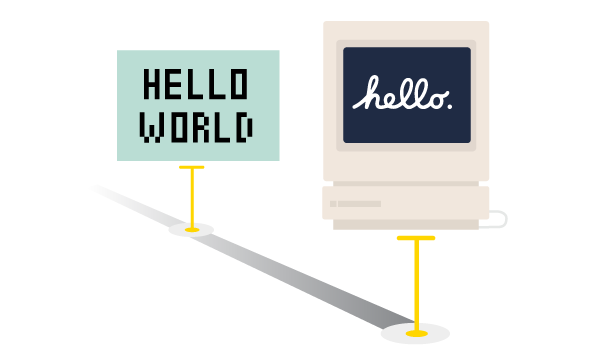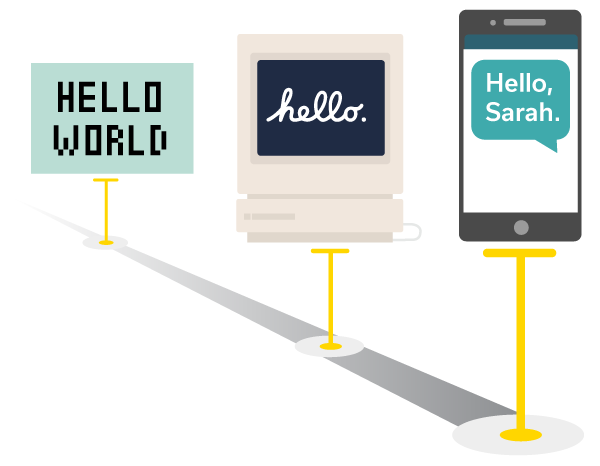Technology innovation is moving at an exponential pace. Think about what has happened in just the past 50 years. If you’re old enough, maybe you remember the Apollo Guidance Computer and how it helped astronauts get to the moon. It was 70 pounds of bleeding edge tech.
Fast forward a few decades and now almost every person on earth carries an eight ounce smartphone that has more than a million times the horsepower of the Apollo computer. Today, there are few things you can’t do on a smartphone.
One thing that hasn’t changed is human nature. NASA spent millions of dollars training astronauts to use the Apollo Guidance Computer, but today’s consumers are on their own when it comes to figuring out how to use and manage the plethora of smartphone apps at their disposal. In 2021, more than 320 billion mobile apps were downloaded, but just over 6% were still in use after 30 days.
The rapid advancements in small, powerful, mobile technology offer an abundance of capability, but the sheer volume is overwhelming. The result is user fatigue: most people only regularly use a small fraction of the digital tools at their disposal. Mobile app oversaturation has created a user experience issue that presents a dilemma for technology creators that cannot be solved by releasing new versions of the software. The time has arrived to take things up a level to the next generation of user interface — language.
38 Years Ago, Apple Solved the First Consumer Adoption Problem
Consider the emergence of the Personal Computer as it evolved from a very costly gadget for tech nerds to a vital device that has been purchased billions of times. It all started on a winter day in Cupertino.
On January 24, 1984, Steve Jobs introduced the Macintosh to the world. It was a PC with 8MZ Motorola 6800 processor, 128KB of RAM and 3.5-inch disc drive. And it came with a whopping $2,495 MSRP, which is equivalent in purchasing power to about $7,115 today. It was expensive, but everyone suddenly saw the potential of the personal computer.
Until that moment, using a PC required a deep technical expertise where commands like C: + CD\123 + 123.EXE had to be typed on a green screen to run a spreadsheet. It was a User Interface (UI) that only a tiny fraction of people were willing to engage with.
With the Mac, the Graphical User Interface (GUI) was introduced, allowing users to use a trackball “mouse” point and click their way around the screen. MacDraw was introduced which allowed users to make pictures by making or manipulating shapes with the mouse. A spreadsheet or word processor application could be opened by clicking on a small icon. Menus to save, open, print, copy, paste, shut down were accessed by clicking on a row of tabs at the top of the screen.

To the masses, it was a “Whoa!” moment. For the technology industry, it was an inflection point. Microsoft realized MS DOS wouldn’t last and eventually introduced its own graphical user interface — Windows. By the mid 1990s, every office desk and many households had a PC serving as vital digital tools, powering spreadsheets, word processors, video games, and access to the internet.
Since that day in 1984, there have been several major inflection point moments in the consumer technology world. There aren’t many of them, and historians will likely never agree on the exact list, but the PC, the Internet, Mobile, Social Networks, and Smartphones top my list.
Technology inflection points happen when billions of people embrace a new technology and the trajectory of innovation changes course. One thing they all have in common is each major advancement came with an improved, intuitive, simplified user interface. From the Mac GUI, to the Google “search” button, to the Facebook friend request, these innovations made it easy for anyone to engage and achieve desired results and satisfaction. They passed the “can my grandmother use it test”.
7 Million Mobile Apps Create Engagement Headwinds
Today, most people are addicted to their smartphone and as a result, every business and government entity on earth is investing in mobile apps. There are now millions of apps, each with its own unique UI, many requiring users to create accounts with passwords, and all of them requiring a download from an app store.
The proliferation of apps is massive, but most apps are rarely used because people are overwhelmed. The average person only uses nine apps daily, and about 30 on a monthly basis.
The smartphone will continue to dominate as the primary digital device for most of the world’s population. But the time has come to seriously reconsider if launching hundreds of thousands of new mobile apps each year is the best strategy. This is especially true for businesses that are trying to build digital relationships with their customers.
Language Turns the Smartphone into Digital Assistants
The explosion of mobile apps isn’t the only thing that has been taking place in mobile technology. There is a lot of incredible innovation happening “under the hood” that is making things better. More processing power, faster chips, smaller devices, better cameras, and wearables are all examples.
One of the most significant innovations is taking place in the area of language — specifically people using words to interact with devices. Siri and Alexa are two well known examples. The technology is advancing to a point where words will soon replace keyboards, touch screens, and yes, even the mouse!
Conversational AI is making its way into the world of business. Instead of asking Siri for directions to the airport, imagine asking your smartphone to pay a bill, or check you in to a doctor's appointment. This language-based user interface will likely be the next big technology inflection point.

We are closer to talking and interacting with machines through simple language than most people think. Right now, there are countless examples of text-based conversational digital assistants taking on complex administrative tasks in finance and healthcare. Banner Health is one of the largest health systems in the nation and they are replacing physical waiting rooms with digital assistants that check patients in through interactive text messaging on patients’ smartphones.
These digital assistants leverage powerful features native on the mobile phone itself, like SMS, web browsers, cameras, maps, wallets, and calendars, that do everything an app would do, but without the hassle. No apps to download. No passwords to remember. No user interface to figure out.
For the 99.999% of businesses that see the potential of establishing long term digital engagement with their customers, Conversational AI is likely the only way to pull it off. By removing the friction that comes with mobile apps and using the increasing built-in power of smartphones, they can offer an easier, more intuitive, and stickier user experience that’s key to success.
Driving engagement with customers is vital and businesses must go where they are spending their time — on their smartphones. When Steve Jobs showed the world what a simple UI looked like and then followed it up 23 years later with the iPhone, he probably never imagined that the little app icons would gradually give way to the device itself. But that’s exactly what is happening.








